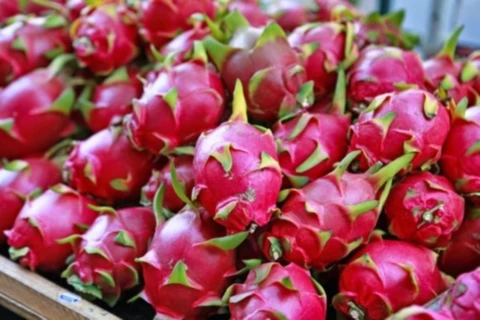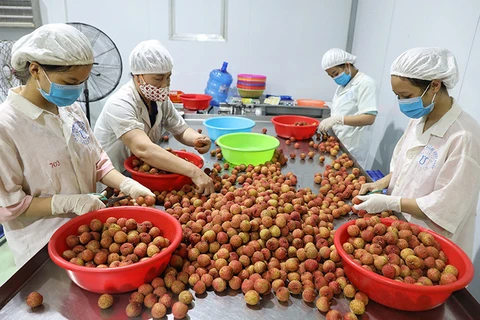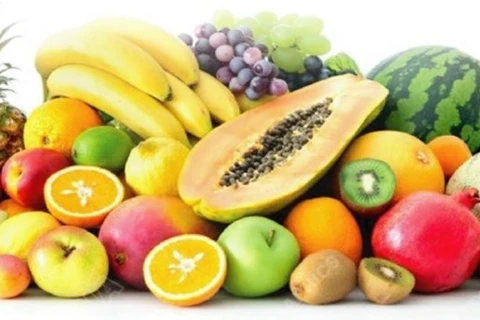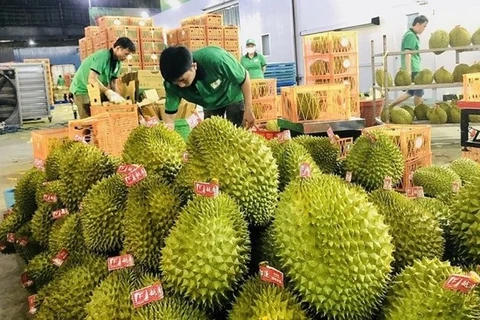 Vietnam now has nearly 55,000ha of dragon fruit farming and harvests an annual output of about 1.3 million tonnes. (Photo: VNA)
Vietnam now has nearly 55,000ha of dragon fruit farming and harvests an annual output of about 1.3 million tonnes. (Photo: VNA) Vietnam now has nearly 55,000ha of dragon fruit farming and harvests about 1.3 million tonnes each year. The favourable soil and climate conditions have enabled the country to produce dragon fruit on a large scale all year round. As a result, it used to be the world’s leader in terms of the farming area, output, and export value, said Nguyen Quoc Manh, head of the fruit tree division of the Crop Production Department at the Ministry of Agriculture and Rural Development.
However, after conquering several markets for a certain period of time, the fruit from Vietnam is facing a number of challenges, he noted, pointing out the foreign markets’ increasingly stringent standards for quality, food safety, and look of fresh dragon fruits, the emergence of many pests and diseases caused by climate change impacts, soaring fertiliser prices, the unsustainable connectivity between businesses and farmers, the limited number of companies involved in value chains to meet requirements of major and demanding markets, and the shortage of advanced processing, packaging, and preservation facilities.
China, the main market of Vietnamese dragon fruit, has applied increasingly strict quality standards. Meanwhile, exports to such new markets as India and demanding ones like Japan, the Republic of Korea, the EU, and the Americas, as well as consumption in the domestic market and the processing industry haven’t recorded good growth.
Besides, the area of dragon fruit farming elsewhere in the world has been expanding fast. While the farming area and output in China have surpassed Vietnam’s, India – a big and potential market – is also working to raise the farming area from 3,000ha at present to 50,000ha in the next five years, Manh noted.
Therefore, dragon fruit export is forecast to encounter difficulties in the coming time if Vietnam enlarges the farming area and does not move to improve quality to meet importing markets’ standards, the official went on.
Echoing the view, Tran Thanh Binh, head of the agro-forestry-fishery export and import division of the Foreign Trade Agency at the Ministry of Industry and Trade, said dragon fruit is one of the key fruit exports. About 80 - 85% of the dragon fruit output is exported while the remainder sold in the domestic market.
Dragon fruit used to generate up to 1 billion USD in exports for Vietnam, but the value has declined over the last three years. It stood at 450 million USD during the first eight months of 2023, down 4.4% year on year, data show.
Manh said that as many countries are increasing their dragon fruit farming area and output, the agricultural sector does not advocate the cultivation area expansion, especially in the areas with unfavourable land and climate conditions. The area and output should be maintained at 60,000 - 65,000ha and 1.3 - 1.5 million tonnes.
Localities need to apply advanced production processes, ensure productivity, improve the look, quality, food safety, and origin traceability of the fruit, cultivate the varieties matching different markets’ demand, form production zones appropriate to export markets, boost the connectivity between farming zones and processing and exporting businesses, maintain traditional market and develop new ones, and upgrade processing and preservation facilities, according to Manh.
Binh perceived that apart from challenges, there remain opportunities for dragon fruit export thanks to the free trade agreements Vietnam has joined, the recovering global demand for farm produce, and falling sea transport expenses.
She recommended ministries and sectors assist localities to sell the fruit in the domestic market, facilitate the export via northern border gates and official channels, improve quality to diversify markets, and capitalise on trade promotion and business matching programmes.
Patrick Haverman, Deputy Resident Representative of the UN Development Programme (UNDP) in Vietnam, suggested the country focus on quality instead of quantity and maintain concentrated production in such provinces as Binh Thuan, Long An, and Tien Giang to apply Good Agricultural Practice (GAP) standards and the ones on quality, safety, environmental protection, and climate change adaptation.
To do so, farmers and the parties involved in the dragon fruit value chain should adopt a market-oriented production mindset, form specialised farming zones appropriate to main markets, and upgrade the connections within the value chain from producers, processors to the logistics system.
Besides, he added, consumers now tend to prioritise low-emission agricultural products, so Vietnam’s dragon fruit sector should build and expand green production models, and minimise emissions and inputs to promote the fruit’s value and competitiveness./.
VNA
























